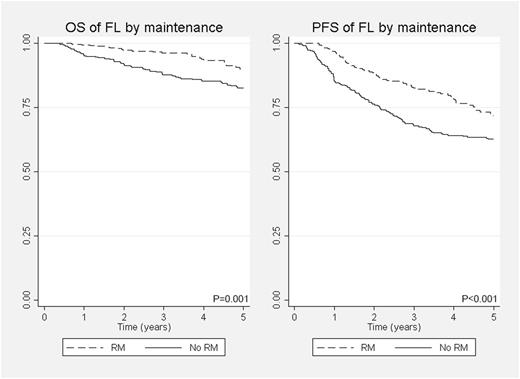Abstract
Introduction: In Denmark, as in most other Western countries, follicular Lymphoma (FL) is the second most common lymphoma entity. Although still regarded as an incurable condition, FL is characterized by an indolent clinical course, a natural history of recurrent relapses and in some cases transformation to an aggressive histology (HT). The addition of the anti CD20 antibody Rituximab to chemotherapy (r-chemo) has had a profoundly favorable impact on the time to relapse, survival and possibly also transformation rates (N. Wagner-Johnston et al, Blood, 2015; C. Sarkozy et al, JCO, 2016). During the last decade maintenance with Rituximab after initial immuno-chemotherapy, has been introduced with the hopes of further improving outcome for patients with FL.
Aims: In this population-based study of real world data, we investigated the effect of upfront Rituximab maintenance (RM) on progression, survival and HT in FL patients.
Patients and Methods: Patients diagnosed with histologically verified FL or Diffuse Large B-cell Lymphoma (DLBCL) in Denmark from 2000-2015 were identified through the National Danish Pathology Registry. Pathology reports were reviewed for patients diagnosed with both FL and DLBCL during the study period. HT was defined as initial biopsy proven FL diagnosis followed, in the same patient, by a subsequent biopsy-verified FL grade 3B or DLBCL. The identified patient cohort was cross-linked with the Danish Lymphoma Registry (LYFO). From this population, patients were included if meeting the following criteria: (i) completed first-line induction treatment with r-chemo, (ii) alive and eligible for RM at the time of clinical evaluation after induction treatment, and (iii) no evidence of HT at the same time point. Decision of treatment-free follow up or RM was applied according to local guidelines (RM was introduced at different time-points at different lymphoma-treating tertiary centers in Denmark). The RM-schedule consisted of 375 mg/m2 intravenous or subcutaneous every other month for 2 years.
Statistical methods: Patient characteristics were compared using Fisher's exact or Student's t test. All time related end-points were estimated by Kaplan-Meier time-to-event analyses and compared using the log-rank test. Overall survival (OS) was defined from the date of FL diagnosis to the date of death by any cause or censoring; Progression-free survival (PFS) was calculated from the date of FL diagnosis to the date of progression/relapse or censoring. Time-to-transformation (TTT) was calculated from the date of FL-diagnosis to the date of biopsy proven HT. Factors of potential clinical relevance were tested in a multivariate analysis using a Cox proportional Hazards model.
Results: 722 patients had completed their first Rituximab-containing induction treatment; 364 patients were consolidated with RM while 358 were not. The two treatment cohorts (no-RM vs. RM) were comparable in terms of sex and age distribution as well as performance score and LDH-elevation. Patients receiving RM had more often advanced Ann Arbor stage (p<0.001), higher FLIPI-score (p<0.001), heavier tumor burden (p<0.001) and bone marrow involvement (p=0.012). As compared to no-RM patients, those consolidated with RM had a significantly improved 5-year OS (83% vs. 90%; p=0.003) and PFS (63% vs. 72%; p<0.001) at univariate level and confirmed in multivariate analysis (fig. 1). Similarly, the rate of HT was reduced in RM treated patients (10% vs. 6%; p=0.067) and the mean TTT was prolonged (1.8 yrs vs. 2.7 yrs; p=0.052).
Conclusions: Upfront consolidation with RM after initial treatment with r-chemo in patients with FL results in improved OS and PFS. Furthermore, after RM HT seems to occur less frequently and the event is significantly postponed.
No relevant conflicts of interest to declare.
Author notes
Asterisk with author names denotes non-ASH members.


